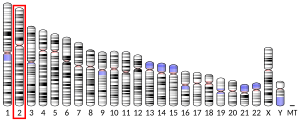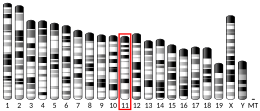MEIS1
Appearance
Homeobox protein Meis1 is a protein that in humans is encoded by the MEIS1 gene.[5][6]
Function
[edit]Homeobox genes, of which the most well-characterized category is represented by the HOX genes, play a crucial role in normal development. In addition, several homeoproteins are involved in neoplasia. This gene encodes a homeobox protein belonging to the TALE ('three amino acid loop extension') family of homeodomain-containing proteins.[6]
Interactions
[edit]MEIS1 has been shown to interact with PBX1[7][8][9] and HOXA9.[7][10]
References
[edit]- ^ a b c GRCh38: Ensembl release 89: ENSG00000143995 – Ensembl, May 2017
- ^ a b c GRCm38: Ensembl release 89: ENSMUSG00000020160 – Ensembl, May 2017
- ^ "Human PubMed Reference:". National Center for Biotechnology Information, U.S. National Library of Medicine.
- ^ "Mouse PubMed Reference:". National Center for Biotechnology Information, U.S. National Library of Medicine.
- ^ Moskow JJ, Bullrich F, Huebner K, Daar IO, Buchberg AM (October 1995). "Meis1, a PBX1-related homeobox gene involved in myeloid leukemia in BXH-2 mice". Molecular and Cellular Biology. 15 (10): 5434–5443. doi:10.1128/mcb.15.10.5434. PMC 230793. PMID 7565694.
- ^ a b "Entrez Gene: MEIS1 Meis homeobox 1".
- ^ a b Shen WF, Rozenfeld S, Kwong A, Köm ves LG, Lawrence HJ, Largman C (April 1999). "HOXA9 forms triple complexes with PBX2 and MEIS1 in myeloid cells". Molecular and Cellular Biology. 19 (4): 3051–3061. doi:10.1128/mcb.19.4.3051. PMC 84099. PMID 10082572.
- ^ Shanmugam K, Green NC, Rambaldi I, Saragovi HU, Featherstone MS (November 1999). "PBX and MEIS as non-DNA-binding partners in trimeric complexes with HOX proteins". Molecular and Cellular Biology. 19 (11): 7577–7588. doi:10.1128/mcb.19.11.7577. PMC 84774. PMID 10523646.
- ^ Jacobs Y, Schnabel CA, Cleary ML (July 1999). "Trimeric association of Hox and TALE homeodomain proteins mediates Hoxb2 hindbrain enhancer activity". Molecular and Cellular Biology. 19 (7): 5134–5142. doi:10.1128/mcb.19.7.5134. PMC 84356. PMID 10373562.
- ^ Shen WF, Montgomery JC, Rozenfeld S, Moskow JJ, Lawrence HJ, Buchberg AM, et al. (November 1997). "AbdB-like Hox proteins stabilize DNA binding by the Meis1 homeodomain proteins". Molecular and Cellular Biology. 17 (11): 6448–6458. doi:10.1128/MCB.17.11.6448. PMC 232497. PMID 9343407.
Further reading
[edit]- Allen TD, Zhu YX, Hawley TS, Hawley RG (October 2000). "TALE homeoproteins as HOX11-interacting partners in T-cell leukemia". Leukemia & Lymphoma. 39 (3–4): 241–256. doi:10.3109/10428190009065824. PMID 11342305. S2CID 27407074.
- Bonaldo MF, Lennon G, Soares MB (September 1996). "Normalization and subtraction: two approaches to facilitate gene discovery". Genome Research. 6 (9): 791–806. doi:10.1101/gr.6.9.791. PMID 8889548.
- Steelman S, Moskow JJ, Muzynski K, North C, Druck T, Montgomery JC, et al. (February 1997). "Identification of a conserved family of Meis1-related homeobox genes". Genome Research. 7 (2): 142–156. doi:10.1101/gr.7.2.142. PMID 9049632.
- Smith JE, Bollekens JA, Inghirami G, Takeshita K (July 1997). "Cloning and mapping of the MEIS1 gene, the human homolog of a murine leukemogenic gene". Genomics. 43 (1): 99–103. doi:10.1006/geno.1997.4766. PMID 9226379.
- Shen WF, Montgomery JC, Rozenfeld S, Moskow JJ, Lawrence HJ, Buchberg AM, et al. (November 1997). "AbdB-like Hox proteins stabilize DNA binding by the Meis1 homeodomain proteins". Molecular and Cellular Biology. 17 (11): 6448–6458. doi:10.1128/MCB.17.11.6448. PMC 232497. PMID 9343407.
- Knoepfler PS, Calvo KR, Chen H, Antonarakis SE, Kamps MP (December 1997). "Meis1 and pKnox1 bind DNA cooperatively with Pbx1 utilizing an interaction surface disrupted in oncoprotein E2a-Pbx1". Proceedings of the National Academy of Sciences of the United States of America. 94 (26): 14553–14558. Bibcode:1997PNAS...9414553K. doi:10.1073/pnas.94.26.14553. PMC 25052. PMID 9405651.
- Sanger Centre, Washington University Genome Sequencing Center (November 1998). "Toward a complete human genome sequence". Genome Research. 8 (11): 1097–1108. doi:10.1101/gr.8.11.1097. PMID 9847074.
- Shen WF, Rozenfeld S, Kwong A, Köm ves LG, Lawrence HJ, Largman C (April 1999). "HOXA9 forms triple complexes with PBX2 and MEIS1 in myeloid cells". Molecular and Cellular Biology. 19 (4): 3051–3061. doi:10.1128/MCB.19.4.3051. PMC 84099. PMID 10082572.
- Jacobs Y, Schnabel CA, Cleary ML (July 1999). "Trimeric association of Hox and TALE homeodomain proteins mediates Hoxb2 hindbrain enhancer activity". Molecular and Cellular Biology. 19 (7): 5134–5142. doi:10.1128/MCB.19.7.5134. PMC 84356. PMID 10373562.
- Knoepfler PS, Bergstrom DA, Uetsuki T, Dac-Korytko I, Sun YH, Wright WE, et al. (September 1999). "A conserved motif N-terminal to the DNA-binding domains of myogenic bHLH transcription factors mediates cooperative DNA binding with pbx-Meis1/Prep1". Nucleic Acids Research. 27 (18): 3752–3761. doi:10.1093/nar/27.18.3752. PMC 148632. PMID 10471746.
- Shanmugam K, Green NC, Rambaldi I, Saragovi HU, Featherstone MS (November 1999). "PBX and MEIS as non-DNA-binding partners in trimeric complexes with HOX proteins". Molecular and Cellular Biology. 19 (11): 7577–7588. doi:10.1128/MCB.19.11.7577. PMC 84774. PMID 10523646.
- Spieker N, van Sluis P, Beitsma M, Boon K, van Schaik BD, van Kampen AH, et al. (January 2001). "The MEIS1 oncogene is highly expressed in neuroblastoma and amplified in cell line IMR32". Genomics. 71 (2): 214–221. doi:10.1006/geno.2000.6408. PMID 11161815.
- Wang Y, Yin L, Hillgartner FB (June 2001). "The homeodomain proteins PBX and MEIS1 are accessory factors that enhance thyroid hormone regulation of the malic enzyme gene in hepatocytes". The Journal of Biological Chemistry. 276 (26): 23838–23848. doi:10.1074/jbc.M102166200. PMID 11331288.
- Okada Y, Nagai R, Sato T, Matsuura E, Minami T, Morita I, et al. (June 2003). "Homeodomain proteins MEIS1 and PBXs regulate the lineage-specific transcription of the platelet factor 4 gene". Blood. 101 (12): 4748–4756. doi:10.1182/blood-2002-02-0380. PMID 12609849. S2CID 6532721.
- Zeisig BB, Milne T, García-Cuéllar MP, Schreiner S, Martin ME, Fuchs U, et al. (January 2004). "Hoxa9 and Meis1 are key targets for MLL-ENL-mediated cellular immortalization". Molecular and Cellular Biology. 24 (2): 617–628. doi:10.1128/MCB.24.2.617-628.2004. PMC 343796. PMID 14701735.
- Pineault N, Abramovich C, Ohta H, Humphries RK (March 2004). "Differential and common leukemogenic potentials of multiple NUP98-Hox fusion proteins alone or with Meis1". Molecular and Cellular Biology. 24 (5): 1907–1917. doi:10.1128/MCB.24.5.1907-1917.2004. PMC 350554. PMID 14966272.
External links
[edit]- MEIS1+protein,+human at the U.S. National Library of Medicine Medical Subject Headings (MeSH)
This article incorporates text from the United States National Library of Medicine, which is in the public domain.




